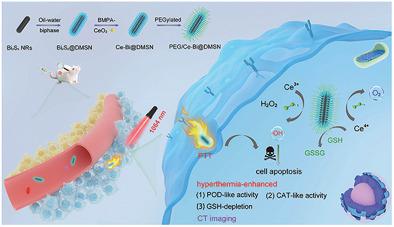当前位置:
X-MOL 学术
›
Adv. Mater.
›
论文详情
Our official English website, www.x-mol.net, welcomes your feedback! (Note: you will need to create a separate account there.)
GSH-Depleted Nanozymes with Hyperthermia-Enhanced Dual Enzyme-Mimic Activities for Tumor Nanocatalytic Therapy.
Advanced Materials ( IF 29.4 ) Pub Date : 2020-09-11 , DOI: 10.1002/adma.202002439 Shuming Dong 1 , Yushan Dong 1 , Tao Jia 1 , Shikai Liu 1 , Jing Liu 1 , Dan Yang 1 , Fei He 1 , Shili Gai 1 , Piaoping Yang 1 , Jun Lin 1, 2
Advanced Materials ( IF 29.4 ) Pub Date : 2020-09-11 , DOI: 10.1002/adma.202002439 Shuming Dong 1 , Yushan Dong 1 , Tao Jia 1 , Shikai Liu 1 , Jing Liu 1 , Dan Yang 1 , Fei He 1 , Shili Gai 1 , Piaoping Yang 1 , Jun Lin 1, 2
Affiliation

|
Nanocatalytic therapy, using artificial nanoscale enzyme mimics (nanozymes), is an emerging technology for therapeutic treatment of various malignant tumors. However, the relatively deficient catalytic activity of nanozymes in the tumor microenvironment (TME) restrains their biomedical applications. Here, a versatile and bacteria‐like PEG/Ce‐Bi@DMSN nanozyme is developed by coating uniform Bi2S3 nanorods (NRs) with dendritic mesoporous silica (Bi2S3@DMSN) and then decorating ultrasmall ceria nanozymes into the large mesopores of Bi2S3@DMSN. The nanozymes exhibit dual enzyme‐mimic catalytic activities (peroxidase‐mimic and catalase‐mimic) under acidic conditions that can regulate the TME, that is, simultaneously elevate oxidative stress and relieve hypoxia. In addition, the nanozymes can effectively consume the overexpressed glutathione (GSH) through redox reaction. Photothermal therapy (PTT) is introduced to synergistically improve the dual enzyme‐mimicking catalytic activities and depletion of the overexpressed GSH in the tumors by photonic hyperthermia. This is achieved by taking advantage of the desirable light absorbance in the second near‐infrared (NIR‐II) window of the PEG/Ce‐Bi@DMSN nanozymes. Subsequently the reactive oxygen species (ROS)‐mediated therapeutic efficiency is significantly improved. Therefore, this study provides a proof of concept of hyperthermia‐augmented multi‐enzymatic activities of nanozymes for tumor ablation.
中文翻译:

GSH耗尽的纳米酶,具有用于肿瘤纳米催化治疗的高热增强型双重酶模拟活性。
使用人工纳米级酶模拟物(纳米酶)的纳米催化疗法是一种用于治疗各种恶性肿瘤的新兴技术。然而,纳米酶在肿瘤微环境(TME)中相对不足的催化活性限制了它们的生物医学应用。在这里,通过用树枝状介孔二氧化硅(Bi 2 S 3 @DMSN)覆盖均匀的Bi 2 S 3纳米棒(NRs ),然后将超小型二氧化铈纳米酶修饰成大分子,从而开发出一种通用且类似于细菌的PEG / Ce-Bi @ DMSN纳米酶。 Bi 2 S 3的中孔@DMSN。纳米酶在酸性条件下具有双重酶模拟催化活性(过氧化物酶模拟和过氧化氢酶模拟),可以调节TME,即同时提高氧化应激和缓解缺氧。另外,纳米酶可以通过氧化还原反应有效地消耗过表达的谷胱甘肽(GSH)。引入光热疗法(PTT)以协同改善双重酶模拟的催化活性,并通过光子热疗消除肿瘤中过表达的GSH。这是通过利用PEG / Ce-Bi @ DMSN纳米酶的第二个近红外(NIR-II)窗口中所需的吸光度来实现的。随后,活性氧(ROS)介导的治疗效率大大提高。因此,
更新日期:2020-10-20
中文翻译:

GSH耗尽的纳米酶,具有用于肿瘤纳米催化治疗的高热增强型双重酶模拟活性。
使用人工纳米级酶模拟物(纳米酶)的纳米催化疗法是一种用于治疗各种恶性肿瘤的新兴技术。然而,纳米酶在肿瘤微环境(TME)中相对不足的催化活性限制了它们的生物医学应用。在这里,通过用树枝状介孔二氧化硅(Bi 2 S 3 @DMSN)覆盖均匀的Bi 2 S 3纳米棒(NRs ),然后将超小型二氧化铈纳米酶修饰成大分子,从而开发出一种通用且类似于细菌的PEG / Ce-Bi @ DMSN纳米酶。 Bi 2 S 3的中孔@DMSN。纳米酶在酸性条件下具有双重酶模拟催化活性(过氧化物酶模拟和过氧化氢酶模拟),可以调节TME,即同时提高氧化应激和缓解缺氧。另外,纳米酶可以通过氧化还原反应有效地消耗过表达的谷胱甘肽(GSH)。引入光热疗法(PTT)以协同改善双重酶模拟的催化活性,并通过光子热疗消除肿瘤中过表达的GSH。这是通过利用PEG / Ce-Bi @ DMSN纳米酶的第二个近红外(NIR-II)窗口中所需的吸光度来实现的。随后,活性氧(ROS)介导的治疗效率大大提高。因此,



























 京公网安备 11010802027423号
京公网安备 11010802027423号